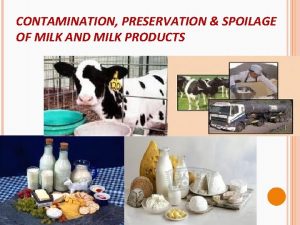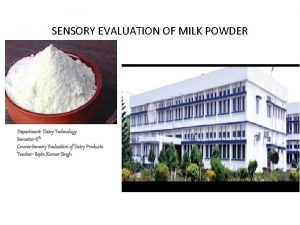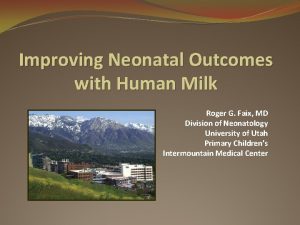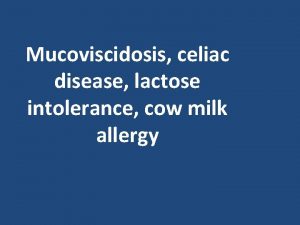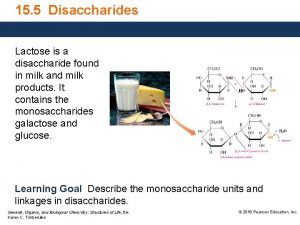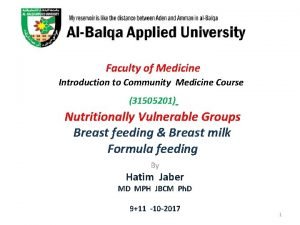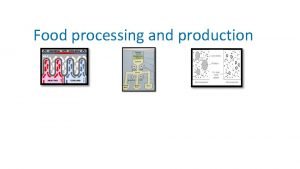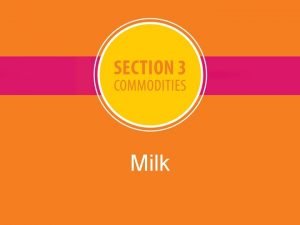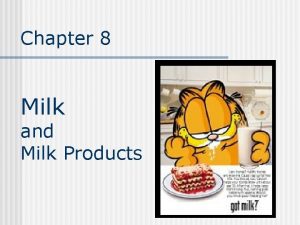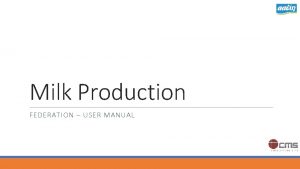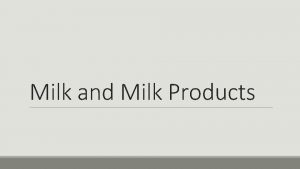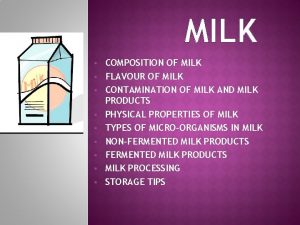AGITATORS IN MILK PROCESSING PLANTS 1 A Alatoxins






- Slides: 6

AGITATORS IN MILK PROCESSING PLANTS 1 A Alatoxins see Mycotoxins: Afatoxins and Related Compounds. AGITATORS IN MILK PROCESSING PLANTS D A Mac. Carthy, J J Fitzpatrick and K Cronin, University College, Cork, Republic of Ireland (A) (B) Copyright 2002, Elsevier Science Ltd. All Rights Reserved Introduction There are many reasons for the agitation of milk and milk products, including: (1) to maintain product uniformity; (2) to promo te heat transfer; and (3) to disperse and dissolve solids in water. H o w ever, excess agitation is to be avoided, as it can cause product damage by disrupting the fat globule membrane and exposing the fat to lipase. Overagitation can also cause the formation of butter granules and nonglobular fat. The types of agitators that are comm only used in the dairy industry are described below. The mechanical and hygienic design of such systems is outlined and the issues involved in the selection and sizing of a particular agitation system are presented. Heat transfer in agitated vessels is explained an overview of the applications of agitation in milk processing is described. Types of Agitators Several types of agitators are used in dairy processing and these can be broadly classified based on the viscosity of the product. Propeller Agitators The three-bladed marine im peller (Figure l A) is a high-speed agitator (400 -17 5 0 rpm) with a small impeller-to-tank diameter ratio (0. 2 -0. 3). It is used Figure 1 (A) Three-bladed marine propeller, showing typical fow pattern for side entry; (B) the axial fow pattern it produces. to agitate low viscosity liquids (usually < 1 Pa s) wherein the mom entum generated by the impeller is easily transferred throughout the liquid. It produces an axial flow pattern (Figure l B ), which gives reasonable mixing and good suspension of particles. Turbine Agitators These agitators have an impeller to tank diam eter ratio in the ran ge of 0. 2 -0. 5, and can be operated at a high speed if required. They are used to agitate low viscosity liquids (usually < 1 Pa s), but they have also been used to agitate liquids with a viscosity as high as 50 Pa s. The basic turbine is a flat-blade design and one of the most comm on turbines is the six flatbladed disc-mounted impeller (Figure 2), which is often used in fermentors. Turbine impellers can

2 AGITATORS IN MILK PROCESSING PLANTS (A) (B) (C) (D) Figure 4 Paddle impellers: (A) basic paddle; (B) anchor; (C) gate and (D) anchor-gate. impellers with greater contact area. There are many variants of the basic paddle (as illustrated in Figure 4) which give greater contact area. Some of these, such as the gate-anchor agitator, can be used with high viscosity liquids up to around 100 Pa s. High-Shear Agitators Figure 2 Six-bladed disc turbine impeller showing typical fow pattern for centre axial entry. induce strong radial flow in addition to axial flow, which imparts a much greater mixing capability than propeller agitators. Pitch-bladed turbines have their blades set at an angle of less than 90 0 from the hori- zontal (Figure 3) and are used in the dairy industry, for example, in lactose crystallization and yoghurt manufacture. The smaller the angle, the milder the agitation as less shear forces are exerted on the liquid and on any particles or droplets within the liquid. Paddle Agitators The basic paddle agitator resembles the basic turbine agitator except that it has a larger impeller to tank diameter ratio ( > 0. 5 to < 1) and rotates at a low speed, typically 1 0 -150 rpm. Paddle agitators are used in the dairy industry to agitate medium viscosity liquids (0. 5 -10 Pa s). Increasing the viscosity will dampen the momentum transfer through the liquid and thus greater contact betw een the impeller and the liquid is required, which results in larger diameter Figure 3 Pitched three-bladed impeller. H igh-shear m ixers are used to break up particles such as in po w der recon stitution or em ulsion drop let form ation. Rotor- stator agitators (Figure 5) are com m on ly used; the produ ct is draw n into a highspeed rotor, typical speed 300 0 rpm , in a closely m achined stator, in w hich the solids are sub ject to m illing and intensive hydraulic shear. This m ay be don e batchw ise in a m ixing vessel, or in-line for con tinuou s blend ing. Pow der m ixing system s are com m ercially available, incorpo rating pow der ho pp er, venturi feeder and in-line m ixer. High-Viscosity Agitators Helical and ribbon-type agitators are used to agitate very high viscosity liquids (up to 1000 Pa s). Air Agitation Milk kept in large storage tanks may be agitated by supplying compressed air near the base of the tank. The air bubbles rise, expand set up circulation currents in the milk. The air supply is regulated using a level detector, which ma tches the air flow-rate to the quantity of milk in the tank. Figure 5 High-shear rotor-stator impeller.

AGITATORS IN MILK PROCESSING PLANTS Mechanical Design The agitation system consists of an electric motor which transmits power through a mechanical drive system. The drive system consists of a power transfer unit (gearbox or belt drive), shaft and impeller, bearings and seals. Figure 6 illustrates in schematic form the basic system configuration. Electric Motor and Gearbox/Belt Drive Electric m otors will rotate at an angular velocity (norm ally 1500 or 3000 rpm) that is too high for the agitator impeller. Thus, a power transfer unit that allows a reduction in rotational velocity will be needed in the system, as in many cases impeller angular velocity will be less than 100 rpm. In the special case where a power transfer unit is not required, the system is referred to as direct drive. Two of the most common types of power transfer unit are the gearbox and belt drive. Gearboxes have the advantage of high torque transmission capability, high dim ensional accuracy and low friction losses, and they predom inate in dairy processing. In many cases, the electric motor and gearbox is supplied as a unit. Belt drives are a flexible power transfer unit with the features of quiet running and good vibration damping properties. They are limited by (relatively low) operating tem peratures and speeds and are not very common in dairy agitation systems. Drive Shaft The drive shaft transmits mechanical power from the electric motor to the impeller. In tall tanks, it may be necessary to fit more than one impeller at different levels on the stirring shaft in order to obtain the required effect. The number of impellers required is approximately equal to the ratio of tank height to tank diam eter. It will be necessary to support this shaft with bearings in order to minim ize friction, wear, noise, deflection and vibration. Bearings can be classified as being journal (plain) bearings or rolling bearings; the latter are generally used. A variety of arrangements to introduce the impeller shaft into the process vessel are possible. The shaft can enter the vessel from the top (top mounted), from the bottom or from the side. The shaft can be parallel, perpendicular or inclined to the vessel longitudinal axis. Top-mounted vertical agitator drives are most comm on, with the shaft either coaxial or eccentric (off-centre) with respect to the vessel axis. Bottom or side entry may be advantageous if more space is needed at the top for entry ports and manifolds or if headspace is limited. The shaft can run the full length of the vessel and be supported by bearings at either end (top and bottom) or can terminate at the impeller and be supported by a bearing at the point of entry into the vessel. Sealing Satisfactory sealing of the rotating agitator shaft is essential for hygienic operation and yet difficult to achieve. As an example, for top-mounted systems, the dripping of lubricant oil from the gearbox into the tank contents is not acceptable even if a food-grade lubricant oil is specified. Any sealing arrangement must be able to resist the appropriate sterilizing tem perature. The most common type of dynamic seal is the axially loaded face seal (mechanical seal). Note that O rings should, generally, be avoided in food contact equipment. Steam shroud Reduction gearbox Rotating driveshaft Electric motor Rotating collar fixed to shaft Impeller Figure 6 Steam in Spring Fixed vessel top plate Drive system for top-mounted agitator. 3 Ball bearing Steam out Seal faces

4 AGITATORS IN MILK PROCESSING PLANTS A m echanical seal con sists of a pair of rings, on e station ary and the other rotating w ith the shaft. They are spring-loaded together and dynam ic sealing takes place betw een their flat annu lar surfaces. M echanical seals m ay be carbo n rings (graphite) rubb ing on carbo n rings or silicon carbide on silicon carbide. Silicon carbide is a ceram ic m aterial, w hich is harder than graph ite and thu s gives a longer seal life. H igh tem perature, low friction plastics, such as Teflon (PTFE), are also used. M echanical seals w ith silicon carbide/carbo n runn ing surfaces are inert un der op erating cond ition s no rm ally encoun tered and are con sidered to be safe in foo d processing. Steam barriers m ay also be used to further guarantee con tainm ent. Hygienic Design H ygienic design of the agitator system involves the consideration of issues that include m aterials of construction, cleanability and surface finish. As food contact surfaces, w hich m ust rem ain inert, im pervious and durable, the shaft and impeller will in all likelihood be built from stainless steel. There are m any grades of stainless steel, but the austenitic grades AISI 304 or AISI 316 are the m ost com mon in dairy applications. M isuse of sterilizing agents (chlorite bleaches) can cause corrosion of stainless steel (see Corrosion). It is for this reason that grade 316 m ay be preferred with its higher resistance to corrosion attack from chloride ions. This also highlights the need for careful water rinsing in the cleaning cycle to ensure that the concentration of chloride ions in inaccessible places, such as any m achine crevices, is not allowed to reach dangerous levels. The surface finish of the agitator affects the ability to clean, sanitize and sterilize the shaft and impeller. Surface finish can be quantitatively measured by the arithmetic mean roughness (Ra) number. Generally, dairy con tact surfaces should have an Ra of less than 0. 8 µm and such a finish is ob tainable by mechanical and electropolishing. i. e. viscosity decreases with increasing shear rate. This results in higher viscosities in regions of the liquid that are more remote from the impeller, which may lead to poor mixing in these regions. Typical values for the viscosity of some dairy liquids are presented in Table l at specified temperatures, as viscosity is usually a strong function of temperature. Agitator Selection of agitator type is determined by the viscosity of the liquid and the agitation job to be performed, whether it be mixing, heat transfer, particle dispersion, oxygen transfer or a combination of these. Each agitator type has a range of viscosities at which it performs best and agitation du ty for which it is best suited, as mentioned above. Equipment suppliers and process design companies have the experience and practical knowledge for selecting an appropriate agitator to perform a specified job. Agitator Dimensions and Speed Once an agitator type is selected, it has to be sized in terms of its dimensions. This will depend on the size of the tank and the volum e to be processed. For a given impeller type, there are standard geometrical configurations for the impeller and tank, which give guidance to sizing the impeller. For most agitation applications, with the exception of heat transfer, there is no well-developed ma thematical analysis supported by property data that can be used to evaluate the effect of impeller speed and diameter on agitation performance. In these cases, it is necessary to evaluate on a small/pilot scale how impeller speed and diam eter affect agitator performance and then scale up these results. Impeller tip speed is usually constrained in dairy processing because of its effect on product quality. Table 1 Typical viscosity of dairy liquids Liquid Agitator Selection and Sizing Viscosity Low viscosity Water Whole a milk liquid Skim milk concentrate resistance to (33% solids) Temperature ( 0 C) 20 to 20 25 flow Viscosity is the resistance of flow. viscosity liquids show little and liquid mom entum is easily transferred througho ut liquid and low power is required to agitate the Medium viscosity On the other hand, high viscosity liquids a 10 have Yoghurt 20 resistance to flow whereby Milk concentrate viscous forces liquid mom entum transfer and (48% solids)require higher 10 Whey concentrate to agitate the liquid. In addition, many dairy liquids (65% solids) are non-Newtonian, and are mainly pseudoplastic, Viscosity (Pa s) 1(10 - 3 ) 2(10 - 3 ) Low 3 13(10 ) thus the liquid. high 1 -4 1 dampen power - 5

AGITATORS IN MILK PROCESSING PLANTS Agitator Power Requirement There are m any po w er curve correlation s available in the literature for estim ating the po w er requ irem ent for specific im peller tank con figuration s, and these are usually presented in the form of po w er nu m ber or fun ction versus Reyno lds nu m ber, as illustrated in Figure 7. O nce the im peller speed and diam eter, liqu id density and viscosity are kno w n, the Reyno lds nu m ber can be calculated. The po w er nu m ber can be read from the po w er curve for the specific im peller tank con figuration , and the po w er requ irem ent can be calculated from the Pow er nu m ber or fun ction. Separate curves are requ ired for baffled and unba ffled system s due to po ssible vortex form ation in un baffled system s. As a general guide, typical m ixing po w er con sum ption varies from 0. 2 k. W m - 3 for low viscosity liqu ids up to 4 k. W m - 3 for blend ing m aterials w ith the con sist- ency of pastes and dou ghs. Vortexing Tangential flow in the direction of rotation of the impeller can lead to vortex formation when agitating low viscosity liquids by centrally mounted impellers in unbaffled tanks. Vortexing due to increasing rotational speed may lead to air entrainm ent by exposing the impeller to air. This can also produce large oscillating forces acting on the impeller shaft. Vortexing can be prevented by mo unting the impeller off-centre or using a horizontal side-entering Laminar impeller. There are cases where vortexing is advantageous, for example, in powder reconstitutio n. When powder is added to the surface of water, the vortex can greatly improve powder sinkability by centrifugally spinning the powder into the water, and this becom es even more important as the solids content of the reconstituted mixture increases. Heat Transfer in Agitated Vessels Heat transfer coefficients for the heating or cooling of a liquid in a jacketed vessel may be calculated using the correlation: N u = a. Re b Pr c (µ/µW ) d where N u = h. D T /k Re = D A 2 Np/µ Pr = heat transfer coefficient (product) (W m Ch µ/k p = k = therm al conductivity (W m - 1 K) agitator diameter D TA = tank diam eter (m) N = rotational speed (s 1 ) p = density (kg m 3 ) C p = specific heat (J kg - 1 K) µ = viscosity (Pa s) µW = viscosity at wall temperature (Pa s) Transition Turbulent P p. N 3 D 5 Power number N P = 101 100 101 102 103 Reynolds number N Re = Figure 7 2 K) Values of a, b, c and d depend on system geometry. 102 100 5 Power curve correlation for estimating agitator power requirement. 104 p. N D µ 2 105

6 AGITATORS IN MILK PROCESSING PLANTS Heat transfer in a jacketed vessel may sometimes be problematic when dealing with medium and high viscosity liquids because of low heat transfer rates and the form ation of deposits on the tank wall. This is overcom e by using paddles with a small clearance between the impeller and the tank wall so that the blade surfaces sweep the wall of the tank clearing away any deposits and preventing a stagnant layer at the wall surface. Applications On-Farm Following milking, milk is stored in refrigerated tanks pending milk collection and delivery to the dairy. Agitation is required for tw o purposes: to improve heat transfer while the milk is being cooled, and to avoid fat separation and facilitate milk sampling for analysis and payment. Typical agitation system: paddle agitator, motor about 100 W, geared down to about 30 rpm. The agitator will operate continuously during cooling, and interm ittently (e. g. 30 s every 15 min) during storage. cream, yoghurt, dairy spreads and dairy desserts. Complete dispersion of the solids in the aqueous phase is required, with no residual lumps and without air incorporation. Particular difficulty is encountered in dispersing stabilizers, e. g. guar gum and locust bean gum, and emulsifiers, e. g. mo no or diglycerides. This is usually achieved using high-shear mixers. Yoghurt Yoghu rt is characterized by a high solids con tent (abou t 20 % ) and m edium to high viscosity depend ing on w hether the yoghu rt is stirred or set. G entle agitation is requ ired to avoid dam age to produ ct texture. T his can be achieved by using a top m oun ted agitator w ith large paddles and a speed of 20 - 60 rpm. Processed Cheese Processed cheese m anufacture is characterized by high viscosity, dispersal of solids and high heating rates. Agitation is achieved by an anchor-type scrapedsurface agitator, at a speed approximating 100 rpm. Milk Intake W hen milk is received at the dairy, it is stored as raw or pasteurized milk. Agitation is required at this stage to m aintain uniform com position for downstream processing and inventory control. Typical agitation systems include: (1) top-entry agitator with m ore than one pitch-bladed impeller; (2) side-entry agitator, m arine propeller, angled down from the horizontal; and (3) air agitation, which is less com monly used because incorporation of air in milk can lead to problems in heat exchangers and cen trifuges. In m odern installations, provision is m ade to inactivate the agitator w hen the product surface is at the height of the agitator. Cream Storage Agitation of cream should be more gentle than agitation of milk because of the greater possibility of product damage. Typical agitation: pitch-bladed or paddle impeller, speed 30 - 6 0 rpm. Milk and Whey Concentrates Milk concentrates are produced by evaporation for dehydration, or by the addition of solids for yoghurt or ice cream manu facture. These products can be effectively agitated using marine propeller or pitch- bladed agitators at 2 0 0 - 400 rpm. Powder Dispersion The dispersion of powders in w ater is required for the manufacture of many dairy products including ice See also: Hygiene in Dairy Production and Processing. Milking and Handling of Raw Milk: Milking Hygiene; Effects of Storage and Transport on Milk Quality. Process and Plant Design. Further Reading Cowan CT and Thomas CR (1988) Materials of construction in the biological process industries. Process Biochemistry 23(1): 5 -11. Hall CW, Farrall AW and Rippen AL (1986) Encyclopedia of Food Engineering. Westport: AVI. Hauser G (1992) Hygienic design of moving parts of machines in the food industry. Transactions of the Institute of Chemical Engineering 70(part C): 138 -142. Holland FA and Chapman FS (1966) Liquid Mixing and Processing in Stirred Tanks. New York: Reinhold. Kessler H G (1981) Food Engineering and Dairy Technology. Freising, Germany: Verlag A. Kessler. Oldshue JY (1985) Mixing processes. In: Bisio A and Kabel RL (eds. ) Scaleup of Chemical Processes. New York: John Wiley. Perry R H and Green DW (1997) Chemical Engineers' Handbook, 7 th edn. New York: Mc. Graw-Hill. Stanbury PF, Whitaker A and Hall SJ (1995) Principles of Fermentation Technology. Oxford: Butterworth- Heinemann. Tetra Pak (1995) Dairy Processing Handbook. Lund, Sweden: Tetra Pak. Uhl VW and Gray JB (1966) Mixing: Theory and Practice. New York: Academic Press.
